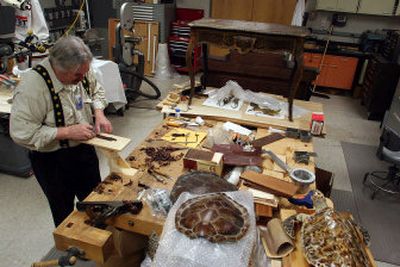Saving the ‘Museum of Me’

WASHINGTON – In my living room, antique Russian brass candlesticks, which are in little danger of damage, have a safe, climate-controlled perch on the mantel. Two flights up in the attic, the fragile Super-8 movie cassette of my wedding stashed in a cardboard box years ago is burning to a crisp in the triple-digit temperatures.
What’s wrong with this picture?
In many homes, the possessions most treasured and irreplaceable are not necessarily the most cared for. How valuable to you is the teddy bear you slept with as a child or a letter your grandfather wrote you in college? These are just the kind of keepsakes that wind up in the two most dangerous places in the house: the attic and the basement, where heat, humidity, water, insects and mildew can wreak havoc on christening gowns, Rolling Stones records, baseball cards, stamp collections and kids’ drawings.
Few people know this better than Don Williams, senior furniture conservator at the Smithsonian Center for Materials Research and Education, the man who has been responsible for taking care of Archie Bunker’s chair, FDR’s desk and the Wright Flyer. As a private consultant, he has advised clients on restoring a $21 million antique. As a collector, he has preserved his dad’s tools, wrapping them in anti-tarnish cloths and storing them in acid-free boxes in his workshop.
Now he has co-authored a book, “Saving Stuff: How to Care for and Preserve Your Collectibles, Heirlooms, and Other Prized Possessions” (Fireside Original/Simon & Schuster, 368 pp. $16), which may inspire the rest of us to go on a rescue mission for our memories.
The book idea began when his friend, Washington writer Louisa Jaggar, had a devastating flood in her basement. Jaggar knew Williams could walk her through the reclamation of her life’s memories, now submerged in more than 2 feet of water. These conversations led to their collaboration on a readable consumer how-to on caring for and preserving heirlooms and prized possessions. The book is part common sense and part cutting-edge science. “We wanted it to be a conversation between an expert and a layman,” says Williams.
Jaggar – who got a scolding from Williams for having stored newspaper clippings, photos and her kids’ art projects on the basement floor – realized that although there were plenty of books about taking care of coin collections or antique furniture, there was no broad-themed resource that included the many kinds of things most people tend to stash away.
“I wanted to figure out how to preserve what is really important for the average person,” says Jaggar. “I figured, who better to do this than the experts at the Smithsonian? If they can save the nation’s history, they can help save the Museum of Me.”
Williams, 50, grew up with an intense interest in woodworking. He got a job at 17 working at a Palm Beach furniture store and then became an apprentice to a master furniture restorer. Among the restorer’s clients were Charles and Jayne Wrightsman, world-class antiques collectors and major benefactors of the Metropolitan Museum of Art. Williams went on to get an art conservation degree at the University of Delaware and Winterthur Museum, and joined the Smithsonian in 1984. The book capitalizes on those years of experience. One chapter covers how to make the tough decisions about which of life’s memorabilia and family heirlooms to save, and which to give away or toss. Sentiment often triumphs over monetary value here. A collectibles risk chart rates the pernicious effects of the enemies of preservation: light, moisture, temperature extremes, handling. Other chapters deal with saving familiar family stuff, ranging from daguerreotypes, plastic action figures, lamps, cane furniture and plastic campaign buttons. Now on their national book tour, Williams and Jaggar have been dishing out advice to people who show up with wedding gowns, family diaries, weasel purses, silver sets and childhood dolls. Says Williams, “It’s clear that one of the reasons people save things, is it allows them to connect with the larger human experience.”
In a cozy, cluttered office in a Smithsonian facility in Suitland, Williams works surrounded by cabinetmaking textbooks, jars of silica gel and the blue nitrile gloves he favors when using chemicals. On a recent visit, with mellow Celtic music playing in the background, we discussed some of the specifics of saving stuff.
• How should we decide what to keep?
Both museums and people think everything is important. But it isn’t equally important. I work in a building designed to preserve objects. But not everyone can care for everything; you have to be selective. Preserving your stuff is more decision-making and will, rather than technology and resources.
• What collectibles are most at risk?
Textiles are the most at risk of all materials. Just about anything can make textiles go bad. They need the most attention.
• Does furniture need all the polish we rub on it?
Furniture is dead. It doesn’t need to be oiled, fed, watered or made supple. So just leave it alone. Keep it clean, dusted and out of the light. You can dust with a lint-free cloth and a few drops of distilled water. • What do you think of the large plastic snap-lid containers so popular these days?
Actually, those plastic containers are pretty much OK as long as they are high-quality, like Rubbermaid, Sterilite or Tupperware. • What’s the best way to make personal time capsules?
Don’t bury them! Put them in a closet – it’s dark and protected, and the things you’ve collected in your capsule won’t disappear into the shroud of the past.
• If attics and basements are so bad, where should we store our most irreplaceable stuff?
The things most prized to you should go on a shelf in your bedroom closet. Above the flood level and below scorching heat. • Are there people who don’t save anything?
I haven’t met them.